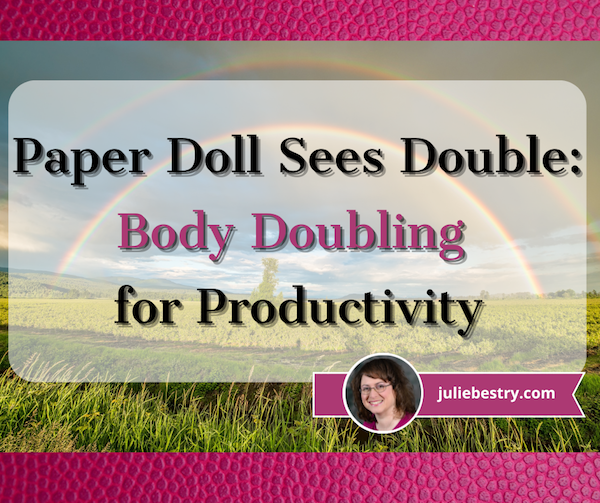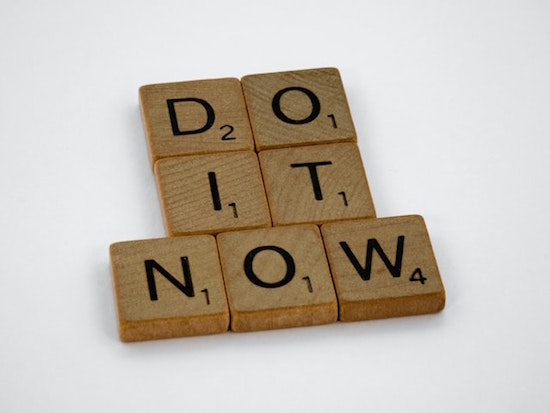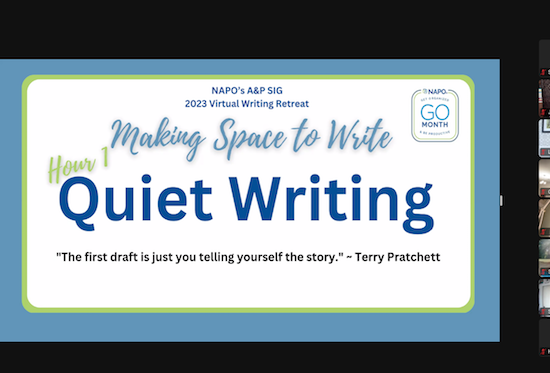Paper Doll Sees Double: Body Doubling for Productivity

Knowing what you have to do and doing it aren’t the same things. If you were raised in the 1980s or 1990s, you learned you were supposed to eat according to the food pyramid. Nowadays, there’s the updated MyPlate approach to healthy eating, to make sure everyone gets the right proportions of fruits and vegetables, grains, protein, and dairy each day.

But knowing how you should eat doesn’t mean that you’ve never contemplated chowing down on break room doughnuts for breakfast. And it’s not just fictional characters like Olivia Pope who’ve had wine and popcorn for dinner.

And while sometimes family, friends, and colleagues can lead us astray from nutritional goals, it’s been proven that hanging out with people whose health goals are similar to yours can help keep you on the straight and narrow.
Simply put, when you’re with people who model good behavior, you’re more likely to participate in that good behavior. So, what does this have to do with organizing or productivity?
BODY DOUBLING AND ACCOUNTABILITY
Two years ago, I wrote Count on Accountability: 5 Productivity Support Solutions, one of the most popular posts I’ve had in the 15+ years I’ve been writing the Paper Doll blog. The concept of getting accountability support to conquer procrastination and achieve more productivity really resonated.
Perhaps you only know about body doubles in movies or on TV. That kind of body double often appears when the featured character is doing something the actor can’t do, like a backflip or fancy dance move. Subsets of body doubles are stunt doubles, or in the case of some films with a bit of nudity, “butt doubles.” However, when we’re talking about productivity, the “butt” is not about someone else’s; it’s about getting your own derriere into the chair to attack avoided tasks.
In that post two years ago, I explained the body doubling technique developed in the ADHD community. In support groups, participants found that when another person was present, participating in quiet tasks with a similar (non-distracting) energy, it helped the individual maintain focus and motivation. We professional organizers often work as body doubles with clients (both those with ADHD and those without) because it successfully creates an environment for focused work.
Any of us on our own (but particularly clients with ADHD) might (intentionally or unintentionally) delay working on a task or get distracted. Realized or unrealized anxiety about a task — fear of failure, for example — can prevent someone from starting, but you have to start in order to have anything you can improve upon. (See: “You can’t edit a blank page.”)
When a project is hanging over your head, you might find ways to delay or distract yourself, but when someone is there, investing their time in you (and you’re investing your time and money to achieve your goals), body doubling helps you push past the anxiety and be more productive.
As a professional organizer, when I’m body doubling with a client, we may be working side-by-side or across from one another. I may pre-sort piles of papers into categories (bills to pay, documents to review, items to file) while the client is working through one category at a time to complete distinct tasks. Students quietly studying for an exam in the library or doing homework in study hall are similarly using the body doubling method to achieve focus and productivity.
Scientific research on the benefits of body doubling are scant, but I can think of at least six (interlocking) ways in which body doubling advances an individual’s ability to stick with a task:
- Accountability — By definition, accountability is “the obligation or willingness to accept responsibility for one’s actions.” You may feel like introducing a second party to get your own work done is cheating, but it’s not.
Really, accepting responsibility means marshaling all of your resources to attack a problem and achieve the stated outcome. If a body double, accountability partner, mastermind or study group, workout partners, or anyone else can help you achieve your goals by their mere presence in your life, availing yourself is no different from having a state-of-the-art computer, a current eyeglass prescription, or properly-fitting running shoes. A body double is just a quiet, human-shaped resource for maintaining accountability.

Studying in Library Photo by Robert Bye on Unsplash
- Social pressure — If someone present with you expects you to get something done, you’re probably going to stick with it and do it. Of course, we’re not all equally responsive to the presence and expectations of others.
Gretchen Rubin’s work on her Four Tendencies framework (how we respond to inner and outer expectations) is a great place to start for understanding the role of social pressure in getting things accomplished.
Some people are Upholders, disciplined at meeting both their own expectations and those of others. Me? I’m an Obliger. I’ve got superior discipline when someone is waiting for me to do something. I am always on time to meetings or appointments, and I deliver what is expected of me by deadlines. However, I’m iffy at goals that only satisfy my own preferences.
Rebels can’t be forced or convinced, but the beauty is that a body double isn’t a boss or a manager telling you what to do. The body double is just mirroring what you’re doing. There’s nothing to rebel against; the body double is just along for the ride. Meanwhile, Questioners can’t be convinced by expectations, only their own pathway to finding meaning in the task. As with Rebels, the body double’s role is as travel companion.
The key is that for those who struggle with getting started or sticking with a task, a partner or several can improve the likelihood of reaching goals.
- Project or task orientation cues — On their own, many people have difficulty maintaining focus on the project at hand. This can be the result of any of a variety of executive function disorders or just a byproduct of living in the 21st century.
For every work-related search you do on Google, you’ll encounter numerous links — both on the search page and then in the sidebars, body, and bottom of the articles you’re reading — specifically designed to take you somewhere else on the web.
On our own, we go down rabbit holes and can’t find our way back to the original link or get trapped in dozens of open browser tabs. Body doubling means that just on the periphery of our consciousness, we’re aware that someone else is present, and that keeps us tethered to our work. We may go astray, but our body double’s presence can bring us (and our focus) back to the here and now.
- Biological cues — The experience of participating in body doubling and mirroring the body double’s behavior can help activate some nifty neurotransmitters. Literally, doing the task cues the bodily systems to kick start, making it easier to hunker down and do the work.

Do It Now Scrabble Tiles by Brett Jordan on Unsplash
- Task execution — “Well begun is half done.” (Aristotle) “You don’t have to be good to start … you just have to start to be good!” (Joe Sabah) “Only put off until tomorrow what you are willing to die having left undone.” (Pablo Picasso)
Such quotes are all well and good, but if you’re using procrastination to soothe your present discomfort, you already know you’re going to feel worse as the deadline approaches. To borrow from what I wrote in my original post on accountability:
Canadian psychology professor and all-around expert on procrastination, Timothy Pychyl, author of Solving the Procrastination Puzzle: A Concise Guide to Strategies for Change, explains that procrastination isn’t just delay. He explains that procrastination is “a voluntary delay of an intended act,” one where the person procrastinating is cognizant that the delay is going to have a cost, whether that cost is financial, interpersonal, professional, legal, or otherwise.
When we procrastinate, we know that there’s no upside; we aren’t merely weighing a logical choice between two options of equal value. It’s less, “geez, how can I decide on whether to go on this romantic anniversary date with my spouse or prepare for my presentation this week?” and more, “Eek, I’m feeling icky about doing this thing for some reason and I’ll latch on to any random thing, like bingeing a sit-com I’ve seen in its entirety three times!”
Experts like Pychyl have found that at its base, procrastination is “an emotion regulation strategy” – a way to cope with a particular emotion while failing to self-regulate and perform a task we know we need to do. We convince ourselves we’d rather feel good now, thereby causing more trouble for our future selves.
Getting started on those tasks is hard. But the minute you have another person there with you, you’ve got a (silent) partner whose presence makes getting procrastinating less possible and doing the (appropriate) activity a smidgen easier.
- Extended focus — It’s common to have trouble sticking with tasks that are boring, repetitive (and thus boring) or lengthy (again, yawn). The presence of others who match your energy and behavior type (reading, writing, doing math homework, sorting, etc.) sprinkles a little extra fairy dust to keep focus a bit longer.
If you were doing a series of Pomodoros (25 minutes of work, 5 minute breaks) on your own, you might give up after one or two. Someone else doing the same or similar tasks in your nearby environment is kind of like keeping pace with another random jogger or bicyclist on your route. If you were on your own, you might give up, but just a little bit of what I think of “competitive companionship” may be all you need to keep going.
To learn more about body doubling, consider:
Could a Body Double Help You Increase Your Productivity? (CHADD)
‘Body doubling,’ An ADHD Productivity Tool, Is Flourishing Online (Washington Post)
Use Body Doubling to Increase Your Productivity (Life Hacker)
How Body Doubling Helps When You Have ADHD (VeryWellMind.com)
I Tried A ‘Body Doubling’ App To Help With Focus – It’s Weird But It Works (Refinery 29)
What to Know About the ‘Body Doubling’ Trend That’s Keeping People with ADHD on Task (Men’s Health)
CO-WORKING FOR ACCOUNTABILITY
Body doubling as a method of accountability has been on my mind lately. In addition to regular client-related work and this blog, I have four special projects in the course of six weeks. I’m being interviewed for a podcast and for a video summit, participating an online summit requiring me to make a video and appear on live virtual panels, and I’ve got an in-person speaking engagement next week. Yikes!
All of these projects require research, writing, and finessing of verbal expression. (I like to be prepared, even when I will eventually have to be extemporaneous.) Deep down, I know it will be fine, but we all have bits of performance anxiety seep in. Timothy Pychyl might say that my temptation toward procrastination is a bit of (messed-up) emotional regulation strategy. But I’ve had (and will soon have more) help in sorting it all out.
Co-Writing Sessions
I’m a member of the Authorship and Publishing Special Interest Group (SIG) in the National Association of Productivity and Organizing Professionals (NAPO). We have monthly meetings and an email group for supporting one another as we write books, articles, blog posts, presentations, and other projects.
Last week, the SIG began holding weekly two-hour co-writing sessions. A small number of us log on to a Zoom call, talk about what we hope to accomplish, and then settle down to write. We each muted our microphones (especially important for me, as I tend to think out loud, which would make it hard to be a silent body double for anyone else), content in the knowledge that if we needed to reach out to our fellow writers, we could type a message into the Zoom chat.
When I minimized the Zoom window, instead of it dropping into the Mac dock or otherwise hiding, it turned into a tiny, floating, repositionable window (about 3/4″ high by 2″ wide). I could see one of my co-writers — in miniature — and it reminded me that I had a goal and that someone <waves hands> out there is on my side in the effort to get my project done.
At the top of the next hour, we turned our mics back on just long enough to check in, offer support, and return to our writing for another hour. I used the first co-writing session to prepare my notes for the summit interview two days later, and felt so confident and prepared because I had this co-writing time.
These are drop-in sessions on a fixed day each week; the participants will change according to each writer’s need and availability, but I’m already looking forward to the next one.
“Making Space to Write” Virtual Writing Retreat
In some ways, that co-writing session was a practice run for an event this past Friday, January 27th. Two of our Authorship & Publishing colleagues, Standolyn Robertson and Leslie Hatch Gail, put a lot of planning into the event. Registration was required, and we had an hour-by-hour retreat agenda.
We were encouraged to set our goals in advance, and once we arrived, after brief introductions and some housekeeping announcements, we hunkered down for 45 minutes of quiet writing time, nudged by a slide with a motivating quote.

(Per participant requests, I am not including any identifying photos.)
Because the live Zoom screen showed the participant gallery and a shared slide, the minimized floating screen wasn’t showing me my colleagues, just the slide. I thought that might lessen my feeling that I was being body doubled, but it didn’t. I was always aware (and calmed by) the slide’s reminder of everyone’s presence.
From then on, at the top of each hour we had 15-minute “human breaks” to stretch, address any biological needs, and answer a prompt slide prompt. Questions were lighthearted and ranged from “What hobbies are you participating in?” to “What was your best purchase in the last year?” We entered our answers on the chat screen, had a little verbal interaction on Zoom, but at the quarter hour mark, we all went back to writing.
What fascinated me was that every time I’d get to a logical stopping point in my writing, ready to take a breather, I’d look at the clock and see it was just the 59 minute mark of the hour!
Around 1 p.m. (in my time zone), we took an hourlong lunch break. Some attendees had to run errands, but for the majority who stayed, it was like having a lunch with co-workers, something we professional organizers (mostly solopreneurs) rarely get to do. Finally, after a full day of writing, we had a social hour during which time we played a rousing and hysterical online version of Scattergories.





Hi Julie! I loved reading your account of our recent Virtual Writing Retreat. I agree with your take on a short weekly co-writing time being nice, and “a few times a year” day-long retreat being something special to plan for and look forward to. As a Questioner with a touch of Rebel, here’s how I think of co-working time: If I’m available at that time, and have something to work on, I don’t mind supporting others by being there. And if I get something done while I’m at it, so much the better! (Spoil alert: I always get something done!) Also, I love “Study Hall for Grownups”! I am looking forward to your future post about apps and hope Focusmate will be one of them because I might want to suggest it to a friend.
Hazel, I had no idea you were a Questioner (with or without a touch of Rebel)! And I’m so glad we got to hang out at the retreat and see your achievement of pushing the “Publish!” button at Amazon’s KDP.
I appreciate the support for Study Hall for Grownups, and yes, Focusmate is on the list for the next post on this topic!
Wait, what’s wrong with wine and popcorn for dinner? I love popcorn for dinner!
I’m an Upholder, so I don’t typically need any external presence to keep me focused. However, I had a real “push” that lasted about 3 months, and I was a bit weary.
One thing I found helpful was a Youtube channel where an animated character is sitting ad working, and instrumental music plays. This is the link: https://www.youtube.com/watch?v=jfKfPfyJRdk
Even though the person is animated, it still felt nice to have her sitting there working as long as I was. Aren’t our brains fascinating?
Seana, you have to shake some grated cheese onto the popcorn to get some protein/dairy. Otherwise, you’ve just got fruits and vegetables!
Your link is fabulous; I wish I’d known about it two years ago when I wrote about all the “faux” accountability methods: https://juliebestry.com/2021/03/08/flow-and-faux-accountability-productivity-focus-and-alex-trebek/
I’m not sure that music would work for me; I need either white noise (like the A/C or washer/dryer) or music I know well, without lyrics, which is basically George Winston on repeat. And, OMG, that whole album is uploaded to YouTube: https://www.youtube.com/watch?v=f5qGUhWPi6w
Who knew?
I’m wondering, do you keep the animated person in a separate window so you can still see her while you’re in your current tab or document?
I just did some virtual body doubling with a long time client this morning! She needed to get through a huge bin of papers and as she said to me, “I’ll never get it done if you’re not there!”
I had signed up for the SIG writing retreat but ended up not being able to attend. 🙁 My husband was on a business trip, my son had an erratic midterm schedule that day and I was caring for my youngest who injured his elbow in a basketball game. No writing time for Mom! But, I’m going to look into those 2 hr co-writing sessions–I have a newsletter to write!
Stacey, our next session is tomorrow (Tuesday) afternoon. I hope I’ll see you there!
And isn’t it wonderful how much we can help our clients for just “being” there with them. Sometimes I compare body doubling to a guided meditation. We help set the framework and then we’re just accompanying them on the journey.
Let’s get your newsletter written!
Tuesday afternoons from 3-5 is when my kids come home from school and need to go in different directions. I’ll look at the Doodle poll that was sent out as well as my calendar and see if I can make it all happen on another day!
Julie, it will probably come as no surprise to you that I am a huge fan of body doubling. I use it often in my client work. While there is no scientific data with statistics to report body doubling is a hugely successful strategy – as you have so beautifully illustrated in your post.
Something you didn’t mention is that body doubling is a calming strategy. I find that when my clients are anxious or stressed over a particular task using this strategy – quietly working alongside them is a calming influence. They get more done in less time and with less stress.
Diane, if anyone could gather some researchers to work with the ICD and NAPO population to study the use of body doubling with clients, it’s you! We don’t need statistics to know it works, but that might help get some venture capital to underwrite body doubling startups and convince insurance companies and employers to support the efforts!
I’m really glad that you referenced the calming aspect of body doubling. While I touched on the reduced anxiety with regard to completing a task, I could have delved much more deeply into the idea of the experience itself being meditative and calming. Thanks for raising that, and for reading!
Thank you for the food for thought. I was trying to figure out how to do body doubling with virtual clients and you have given me some ideas to start thinking about. The four tendencies were a fascinating way to look at social pressure and procrastination.
Thanks for reading. I really like what Diane Q. said up above about the calming nature of body doubling, and think that probably applies virtually, too.
I love this post, Julie! What a great way to explain to a novice what body-doubling is/can be! We, as professional organizers, often use body doubling as a method for accountability with our clients, but not everyone is aware of the benefits. I will definitely share your post with my friends and clients! Thanks!
Thank you, Yve! I think the more people understand body doubling, the more likely people will be to embrace it in their own lives, in the work force, and for their kids! Thanks for reading and for sharing your thoughts.
This is so interesting! And it made me realize I’ve been doing similar things for the reasons you list (but without having given it the thoughtful analysis) for a long time. It may be time to approach it in a more formal way. Thanks for bringing my attention (HAH!) to this excellent post.
LOL, I’m glad your attention is focused on this topic. But seriously, there’s an ebb and flow to how much focus you can bring to the table on any given day, and everything from health and hormones to weather and random babblings can increase or decrease the ease of getting (and keeping) one’s tushy in the chair. A formal or even semi-formal co-working situation really makes a difference for me.